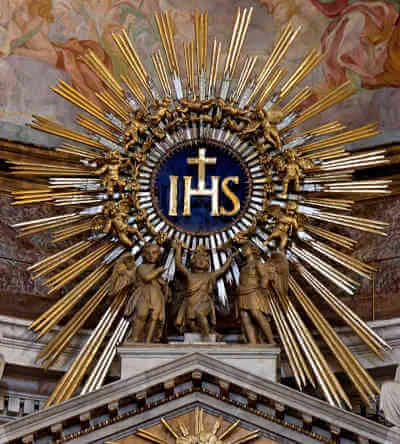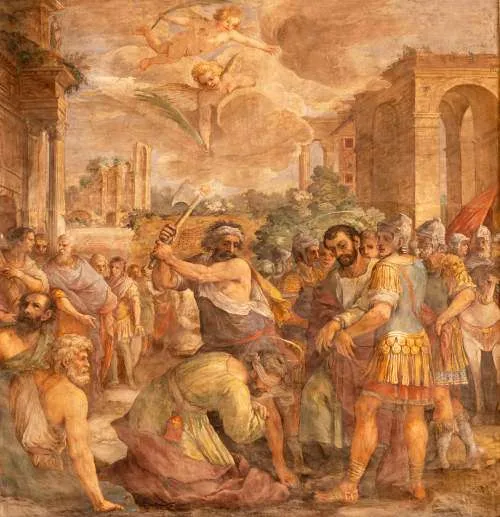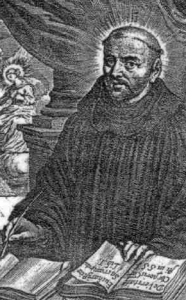c. 480–c. 547; Patron Saint of Europe, monks and religious orders, architects, dying people, cave explorers, schoolchildren, agricultural workers, civil engineers, and coppersmiths Invoked against erysipelas, fever, gallstones, inflammatory diseases, kidney disease, nettle rash, poison, temptations, and witchcraft; Canonized by Pope Honorius III in 1220; Declared Patron Saint of Europe by Pope Paul VI in 1964
Benedict was born into Roman nobility in Nursia, central Italy, roughly 100 miles northeast of Rome. His father was a prefect for the Western Roman Empire, which had fallen to the barbarians a decade prior to his birth. He had a twin sister named Scholastica, who also became a saint. As a youth, Benedict was sent to Rome for studies. However, he quickly became disillusioned by the prevalent immorality and disorder, particularly among his classmates. At the age of twenty, to find peace in his soul and avoid the traps that had ensnared many of his peers, he moved to the countryside of the town of Affile, about forty miles from Rome. Accompanying him was his nurse who cared for him like a mother. They moved in with some virtuous men in the Church of Saint Peter. While there, his nurse accidentally broke a dish used to sift wheat and was distraught. Witnessing this, Benedict miraculously mended the dish and returned it to her. News of this miracle spread quickly, and Benedict became the talk of the town.
Benedict wasn’t interested in the praise of men; he sought only holiness. Leaving his nurse behind, he moved closer to the town of Subiaco and took up residence in a cave. Nearby, he met a holy monk, Romanus, whom Benedict consulted for spiritual advice. At Romanus’ encouragement, Benedict took on the monastic habit and lived in the cave for the next three years as a hermit. Romanus visited him frequently, bringing him food as needed. As a hermit, Benedict prayerfully sought to root out all sin in his life, especially the three temptations common to most men: “the temptation of self-affirmation and the desire to put oneself at the center, the temptation of sensuality and, lastly, the temptation of anger and revenge” (Pope Benedict XVI, General Audience, April 9, 2008).
After having conquered these temptations, Benedict was invited by a group of local monks to become their abbot. He reluctantly agreed, recognizing that his form of religious life contrasted sharply with theirs. After a brief time as abbot, the monks so opposed him that, according to legend, they attempted to kill him by poisoning his wine. When Benedict blessed the wine, the glass shattered, and the scheme was revealed. Shortly afterward, Benedict left the monks and returned to his cave before emerging to found monasteries in the area over the following years. Many admired him and were attracted to his radical way of living, while others envied him and sought his life. Numerous miracles are said to have taken place through his intervention, such as raising a monk from the dead, healing a boy, foreseeing future events, multiplying food and wine, expelling demons, and walking across water.
After founding twelve small monasteries in the Subiaco area, Benedict felt it was time for a fresh start. One of the local priests had tried to poison him and was relentless in his persecutions. He even sent a naked woman to one of Benedict’s monasteries to tempt him and the monks. In addition to this persecution, some monks found his way of life challenging, and the locals were more taken with the stories of his miracles than with his devotion to God. Therefore, he moved about sixty miles southeast to the mountaintop of Monte Cassino, where, at the age of fifty, he founded his most famous monastery.
Upon arriving at Monte Cassino, Benedict found a temple built to the Roman god Apollo. He destroyed it, built two chapels in its place, and then constructed a monastery nearby. Before this, most monasteries consisted of loosely associated hermits living independently but also somewhat communally. Having seen the failure of this form of monasticism in Subiaco, Benedict adopted a new approach. Instead of several smaller monasteries, he built one large monastery where numerous monks could live. He wrote a rule, later known as “The Rule of Saint Benedict,” that guided his newly established monastery at Monte Cassino and eventually became the normative rule for Western monasticism for the next 1,500 years. Hence, Saint Benedict is often referred to as the “Father of Western Monasticism.”
The “Rule” consists of seventy-three short chapters that address both the spiritual and administrative aspects of a healthy monastery. The Rule lays out guidelines for monastic living, particularly in areas of stability, conversion of life, obedience, prayer, work, community life, hospitality, and humility. The Rule takes into consideration the fact that most monks governed under the Rule did not engage in extreme penances or other radical charisms. Instead, the Rule fosters a balanced community life in which individual monks can discover a daily rhythm of prayer, work, and study conducive to a deeper and personal calling to holiness.
While Benedict set up his community at Monte Cassino, his sister, Scholastica, helped found a monastery for women. It’s likely that Benedict played a role in this founding and that his Rule guided the nuns’ daily life. Benedict and Scholastica remained close until her death, which he prophesied. Upon her death, Benedict had a vision of Scholastica being taken to Heaven. He brought her body back to Monte Cassino, where she was buried in his future grave, and which they still share.
After fewer than ten years at Monte Cassino, Benedict died, but his influence on the Church and all of Europe was just beginning. Monasteries across Europe, guided by the Rule of Saint Benedict, developed into important centers for education, medicine, culture, and social development. From these monasteries, universities were born. The monasteries helped to preserve ancient texts, stabilize communities, influence nobility, and draw many to Christ. Their liturgies flourished and influenced the wider Church, making many of these monasteries the central teachers of prayer and worship. For these reasons, many have referred to Saint Benedict as not only the father of monasticism but also the father of modern Europe, given the influence that monasteries using his Rule have had on Europe and the world as a whole. For this reason, Pope Paul VI declared Saint Benedict the Patron Saint of Europe in 1964.
As we honor this important figure in Church and world history, reflect on his humble beginnings. He witnessed the immoralities of his day and fled from those temptations to embrace a life of holiness. At that time, it would have been difficult for him to comprehend the influence he would have had on all of Europe and, in fact, upon the whole world for many centuries to come. Reflect on the fact that God also calls you to flee from sin and embrace a life of holiness. When that happens, God can do great things through you in ways you may never comprehend. Follow the example of Saint Benedict and commit yourself to holy daily living, and leave it up to God to use you as He wills.
Source: https://mycatholic.life/saints/saints-of-the-liturgical-year/july-11—saint-benedict-abbot/







